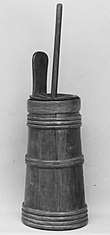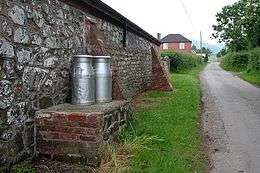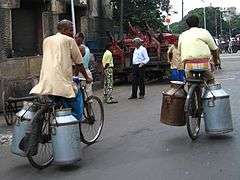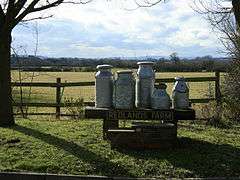Milk churn
.jpg)
A milk churn is a tall, conical or cylindrical container for the transportation of milk.[1] It is sometimes referred to as a milk can.
History

Milk was originally distributed in 'pails', a lidded bucket with a handle. Often two pails would be carried on either end of a wooden carrying yoke. Once the railways started carrying milk, the pail proved less than ideal as it was top-heavy and tended to spill. Dairy farmers used a tall conical wooden container - a butter churn - to 'churn' the milk into butter, and this proved to be preferable for the railways to transport. It held a lot more milk (about seventeen gallons) and its conical shape made it less likely to spill or topple over. These wooden churns were intrinsically heavy, and starting in the 1850s a steel version was introduced and soon became the standard. The usage of the word 'churn' was retained for describing these containers, although they were not themselves used for 'churning' butter.
Function
As with British Railway Milk Tank Wagons, the milk churn was a standard size; the older galvanised iron conical type held 17 gallons, whilst the cylindrical type with the mushroom-shaped lid introduced in the 1930s held ten gallons. Each churn carried a brass plate near the top to identify the owning company and when full it would have a white paper label (tied to the handle on the lid of the conical type and to the side handle of the cylindrical type), which was used for accounting purposes by the creamery or dairy.[2] The use of churns ceased in Britain in 1979.[3] The milk churn was also known as ( Milk Kit ) in the yorkshire dales.
Milk churn stands

In Britain, milk churns would be left by dairy farmers by the roadside on purpose-built platforms, or stands, at the right height to be loaded on to the dairy's cart or lorry. They fell out of use when milk began to be collected by tanker from the farm and ceased entirely by 1979. Some stands remain in the countryside as historical features, but most have been dismantled or left to decay.[4][5][6]
Gallery
 Milk churns being carried on bicycles, Kolkata, India, 2007
Milk churns being carried on bicycles, Kolkata, India, 2007 Variety of types
Variety of types.jpg) Conical churns
Conical churns
References
- ↑ "milk churn - Definition from Longman English Dictionary Online". Ldoceonline.com. Retrieved 2013-04-11.
- ↑ Mike Smith. "Milk - Dairies and Creameries". Igg.org.uk. Retrieved 2013-04-11.
- ↑ "Hansard, 10 July 1978". Retrieved 28 September 2016.
- ↑ "Ceredigion County Council Museum Collection: Milk churn". Retrieved 27 September 2016.
- ↑ "Ceredigion County Council Museum Collection: Milk churn stand". Retrieved 27 September 2016.
- ↑ "People's Collection Wales: Milk churn collection". Retrieved 27 September 2016.